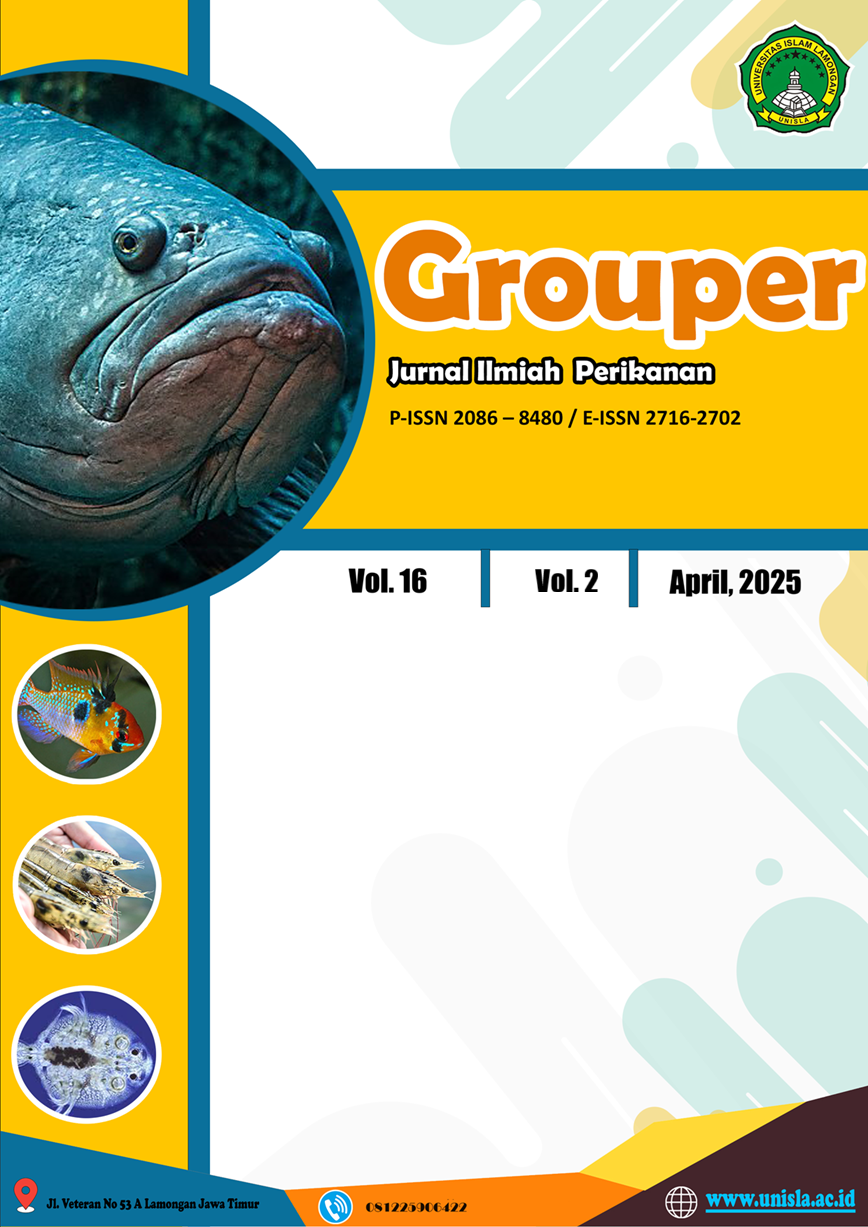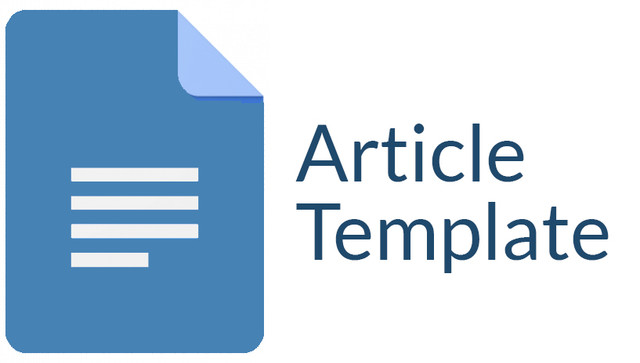Analysis of the Potential and Role of the Fisheries Subsector in the Economy in the Provinces of Sumatra
DOI:
https://doi.org/10.30736/grouper.v16i2.311Keywords:
Sumatra, GRDP, Percentage of Growth Rate, Percentage of Contribution of Fisheries Subsector, LQ, IKS and LIAbstract
This study examines the potential and role of the fisheries sub-sector in the economy of Sumatra's provinces using Gross Regional Domestic Product (GRDP) data from 2004-2023. The analysis includes Growth Rate Percentage, Fisheries Sub-sector Contribution Percentage, Location Quotient (LQ), Sectoral Contribution Index (IKS), and Localization Index (LI). The findings indicate that the fisheries sub-sector growth rate in Sumatra ranges from 7.99% to 46.01%, averaging 22.4%. Its contribution to the agricultural sector varies from 6.20% to 67.63%, with an average of 20.81%, while its share of total GRDP is between 1.69% and 6.53%, averaging 3.75%. The LQ values range from 0.56 to 2.17, with an average of 1.24, indicating that this sub-sector is a base industry with production exceeding local consumption. However, the IKS values (0.02-0.07, averaging 0.04) suggest that the fisheries sub-sector is not yet a key sector. The LI values (0.01-0.09, averaging 0.03) reflect a relatively balanced distribution across Sumatra. Overall, the fisheries sub-sector contributes significantly to regional and national economic growth. However, the low IKS value indicates that its potential remains underutilized. To maximize this potential and enhance export competitiveness, strategic support through innovative policies, infrastructure investment, and modern technology adoption is essential.
Downloads
References
Akbar Dhani., Anggria Pratama Ryan., Yudhyo, Lisnawati Sianturi Riama and Triyana Nadya. 2022. Blue Economy Development Strategy in Indonesian Border Regions: Coastal Maritime Economic Governance of the Riau Islands. 4. (1). pp. 166-177 ISSN Online: 2716-0777 Journal Homepage.
Aminah S. 2011. Analysis of the utilization of mackerel fish resources (Rastrelliger Spp) in the waters of Tanah Laut Regency, South Kalimantan Province. Fish Scientiae Vol. 1 (2): 179 – 189.
Arham Hafidh Akbar, Adibrata Sudirman, Adi Wahyu. 2019. Association of Megabenthos with Coral Reef Ecosystem in the Waters of Perlang Village, Central Bangka, Bangka Belitung. Journal of Aquatic Resources. Volume 13 Number 2, 2019.
BPS. 2023. Gross Regional Domestic Product of Provinces in Indonesia According to Business Fields 2019-2023.Badan Pusat Statistik (BPS). 2021. Statistik Produk Domestik Regional Bruto 2021. Badan Pusat Statistik Republik Indonesia.
Central Bureau of Statistics of South Sumatra Province. 2023. Plantation Crop Production.
Dahuri, R. 2018. Coastal and Marine Area Development in Economic and Environmental Perspectives. Jakarta.
Destiningsih Rian, Septiani Yustirania, and Marlina Verawati Dian. 2020. Contribution and Distribution of Fisheries Subsectors in the Special Region of Yogyakarta. Central Java, 1(2),82-89.
Hamidi Wahyu, Sari Mayang and Ningsih B. 2011. Contribution of the Fisheries Sector to Improving the Economy of Riau Province. Journal of Economics. University of Riau.
Jambi Province Marine and Fisheries Service. 2022. Fisheries Production Report 2022. Jambi: Jambi Marine and Fisheries Service.
Lampung Province Marine and Fisheries Service. 2022. Fisheries Production Report 2022. Bandar Lampung: Lampung Marine and Fisheries Service.
Ministry of Marine Affairs and Fisheries of the Republic of Indonesia. 2020. Fisheries Resources in Sumatra Province. Ministry of Marine Affairs and Fisheries of the Republic of Indonesia.
Ministry of Marine Affairs and Fisheries. 2022. Marine Fisheries Statistics.
Ministry of Marine Affairs and Fisheries. 2023. Marine Fisheries Statistics.
Morrissey, K. 2014. Producing regional production multipliers for Irish marine sector policy: A location quotient approach. Ocean and Coastal Management, 91, 58–64.
Muta’ali, L. 2015. Regional Analysis Techniques for Regional, Spatial, and Environmental Planning. Faculty of Geography Publishing Agency (BPFG), Universitas Gadjah Mada: Yogyakarta.
Mulyasari, G. 2015. Prospects for Developing Capture Fisheries Business in Bengkulu City. Journal of Social Economic of Agriculture. 4(2): 1-7.
Mustofa, A. 2017. The Role of the Fisheries Sector in the National Economy. Jakarta: Gramedia Pustaka Utama.
Nugroho, Y. 2020. "The Role of GRDP in Improving Community Welfare." Journal of Economics and Development, 12(3), 85-101.
Nurkholis, Nuryadin, D., Syaifudin, N., Handika, R., Setyobudi, R. H., & Udjianto, D. W. 2016. The Economic of Marine Sector in Indonesia. Aquatic Procedia, 7, 181–186.
Oktavilia, S., Firmansyah, Sugiyanto, F. IOP Conference Series: Earth and Environmental Science, 246.
Rad;, F., and Rad, S. 2012. A Comparative Assessment of Turkish Inland Fisheries and Aquaculture Using Economic Sustainability Indicators. Turkish Journal of Fisheries and Aquatic Sciences, 12, 349–361.
Riau Province Marine and Fisheries Service. 2022. Fisheries Production Report 2022. Pekanbaru: Riau Marine and Fisheries Service.
Rustiadi, E., S. Saefulhakim, dan D.R. Panuju. 2011. Perencanaan dan Pengembangan Wilayah. Crestpent Press dan Yayasan Obor Indonesia: Jakarta.
Satria, A., and Matsuda, Y. 2004. Factors Affecting Fisheries Development Performance: Case Study in Indonesia. Journal of Fisheries and Marine Extension, 8(1), 1-15.
Sjafrizal. 2008. Regional Economy, Theory and Application. Baduose Media First Printing, Padang.
Sjafrizal. 2014. Regional and Urban Economics. Ed.1-2. RajaGrafindo Persada: Jakarta.
Sudirman. 2018. Fisheries Resources Management in Indonesia. Jakarta: Indonesian Fisheries Science Publisher.
Sukirno, S. 2007. Macroeconomics: Introductory Theory. Jakarta: RajaGrafindo Persada.
Sumatra Province Marine and Fisheries Service. 2022. Annual Fisheries Statistics Report.
Setyawan, B. (2021). Coastal Area Development Through the Fisheries Sector. Surabaya: ITS Publisher.
Syahrial, and Herman, W. 2019. Leading Food Commodities (Rice, Corn and Soybeans) in Urban Areas in West Sumatra Province. Tata Loka, 21(3), 537– 543.
Law Number 17 of 2008 Concerning Shipping.
Regulation of the Minister of Marine Affairs and Fisheries Number 2012 concerning Fishery Ports
Wibowo BA, Triarso I, Suroyya AN. 2019. Income level of gill net fishermen at the Morodemak Coastal Fishing Port. Indonesian Journal of Capture Fisheries Vol. 2 (3): 29-36
Yuliana, R., Desti, Y., Agit, A., Latuheru, A., Anam, M. K., St Aisyah, R., ... & Rukmana, A. Y. (2024). DASAR-DASAR TEORI EKONOMI MAKRO.
Widodo, S. 2004. Development Economics: Process, Problems, and Policy Basis. Yogyakarta: UPP AMP YKPN.
Widodo, S. 1990. Development Economics: Process, Problems, and Policy Basis. Yogyakarta: UPP AMP YKPN.
Downloads
Published
How to Cite
Issue
Section
License
Copyright (c) 2025 Julia Putri, Firmansyah Firmansyah, Farhan Ramdhani, Bagus Pramusintho, Rizky Janatul Magwa, Putinur Putinur

This work is licensed under a Creative Commons Attribution-NonCommercial-ShareAlike 4.0 International License.







.jpg)
1.png)



